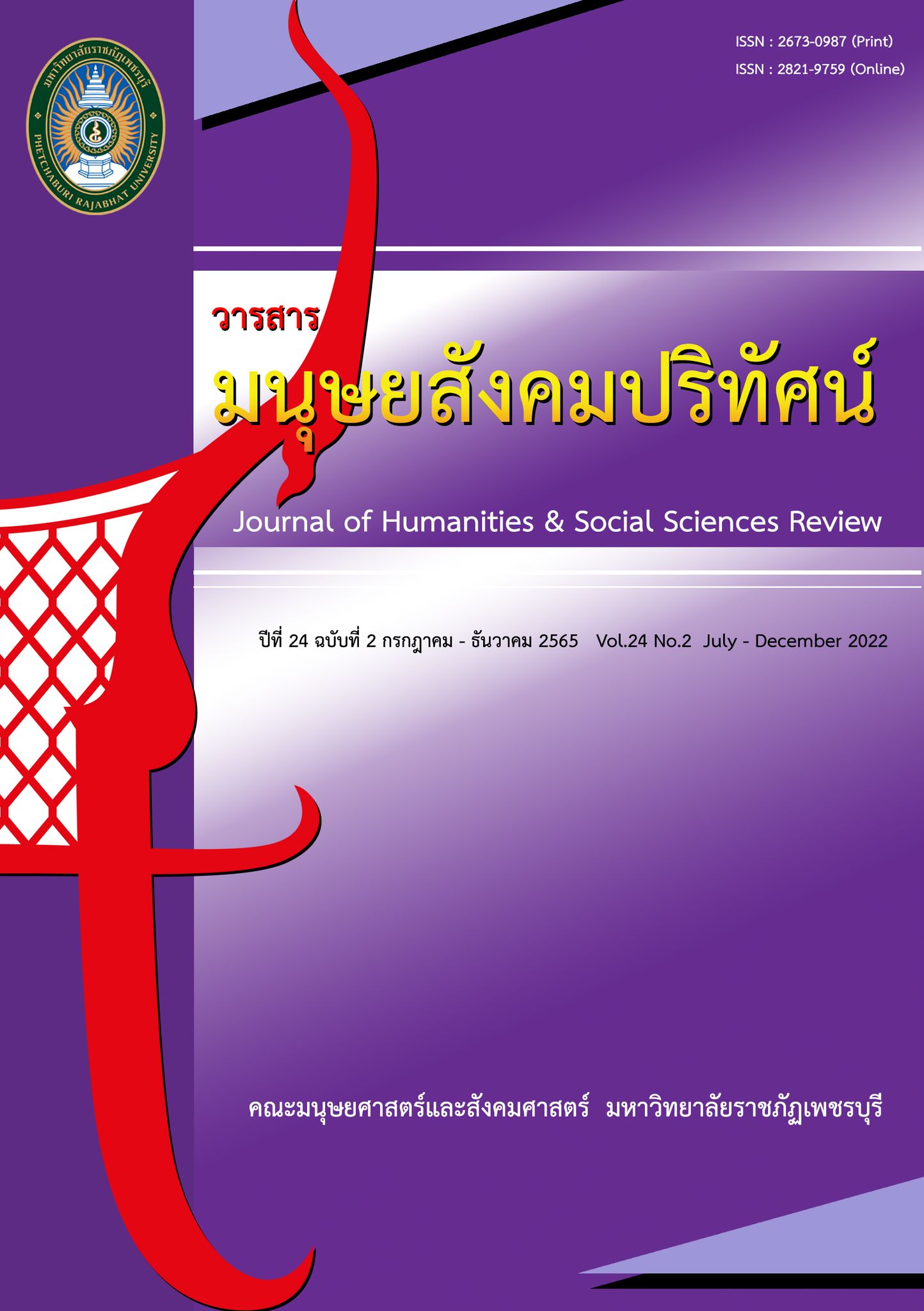Guidelines for creating tourism competitive advantage to enhance the tourism resource component Case study : Bandonnai Laemphakbia Banlaem Phetchaburi
Main Article Content
Abstract
The objectives of this research were 1) to study the composition of tourism resources of the Ban Don Nai community, Laem Phak Bia Subdistrict, Ban Laem District, Phetchaburi, 2) to assess the potential components of tourism resources and the competitive advantage of the Ban Don Nai community, 3) to analyze the composition of tourism resources that affect the building of the competitive advantages in Ban Don Nai community, and 4) to find ways to enhance the components of tourism resources to create a competitive advantage in Ban Don Nai community. The research method was Mixed Method. In-depth interview of 9 key informants by purposive selection and quantitative data were collected through questionnaires. The sample of this research consisted of 400 samples who were Thai tourists by a specific method (Purposive sampling). The researcher used descriptive statistics, analysis of Pearson's Correlation Coefficient and analysis of multiple linear regression (Multiple Linear regression) to analyze data. Finally, the results of the data analysis were gathered using focus group. Purposive sampling consisted of 16 members, those involved in tourism management and academics, to find ways to enhance the composition of tourism resources to create a competitive advantage.
The results showed that when assessing the potential of 8A's tourism components, the study found that the acceptance factor in tourism sites (Acceptance) had the highest potential, followed by the traditional one (Authenticity), and facilities in tourist attractions (Amenities) had the least potential. For the competitive advantage potential in terms of competitive advantages, the study found that differentiation had the highest potential, followed by cost leadership, and the focus on niche markets had the least potential. The results of the analysis of the composition of tourism resources that affect the building of the competitive advantage of the Ban Don Nai community was that tourism resource factors had a positive influence on building competitive advantages of the Ban Don Nai community in 6 variables. The best predictor of generating competitive advantage was the acceptance in tourist attractions used to search for information via mobile phones (Android Application/IOS), Management of services in tourist attractions (Ancillary services), Traditional (Authenticity) tourism attraction (Attractions) and facilities in tourist attractions (Amenities), respectively.
Then, the researcher brought the results of the data analysis to a small group meeting (Focus Group). The community prioritized the development of tourism resources from 6 places according to the community's ability to operate and advise five guidelines for upgrading the components of tourism resources to create a competitive advantage for the community. The first guideline is for developing tourism attractions. The second guideline is for developing facilities and service management in tourist attractions. The third guideline is for developing a program for searching information via mobile phones (IOS/Android). The fourth guideline is for developing acceptance in tourist attractions. The last guideline is for building a successful model for other communities by applying it as a body of knowledge and a shortcut for people to study and visit.
Article Details
1. Any views and comments in the article are the authors’ views. The editorial board has not to agree with those views and it is not considered as the editorial board’s responsibility. In case, there is any lawsuit about copyright infringement, it is considered as the authors’ sole responsibility.
2. The article copyright belonging to Faculty of Humanities and Social Sciences, Phetchaburi Rajabhat University are copyrighted legally. Republication must be received direct permission from the authors and Phetchaburi Rajabhat University in written form.
References
การท่องเที่ยวแห่งประเทศไทย. (2561). การท่องเที่ยวโดยชุมชมอย่างยั่งยืน. สืบค้นเมื่อ 5 สิงหาคม 2562, จาก https://www.tatreviewmagazine.com/article/cbt-thailand/.
ทัศนีย์ นาคเสนีย์. (2560). แนวทางการจัดทำเส้นทางปั่นจักรยานเพื่อการท่องเที่ยวในภูมิภาคตะวันตกเพื่อเชื่อมโยงกับประเทศเพื่อนบ้าน. ใน การประชุมวิชาการระดับชาติครั้งที่ 5 มหาวิทยาลัยราชภัฏหมู่บ้านจอมบึง, วันที่ 1 มีนาคม 2560, มหาวิทยาลัยราชภัฏหมู่บ้านจอมบึง, หน้า 1598-1607.
ธนาคารเพื่อการเกษตรและสหกรณ์การเกษตร. (2560). ท่องเที่ยววิถีไทย ชุมชนบ้านดอนใน. สืบค้นเมื่อ 11 สิงหาคม 2562, จาก http://www.tourvtthai.com/2015/porpeanglife-preview/ 381091791795?fbclid=IwAR0Z7xChckHn9J2CMzJo9c5C8rjKphaJs84YKUm9FXfeUJ2yxRfESIYNOew.
ปุณณ์ณฤณัฏฐ์ ดีจริงตระกูล. (2562). ปัจจัยส่งเสริมการท่องเที่ยวเชิงนิเวศทางทะเลอย่างยั่งยืนในเขตพื้นที่ระเบียงเศรษฐกิจพิเศษภาคตะวันออก: กรณีศึกษาเมืองพัทยา. วารสารวิชาการมหาวิทยาลัยราชภัฏพระนคร, 11(1): 1-19.
ภณสิทธ์ อ้นยะ. (2563). ระดับการมีส่วนร่วมของชุมชนที่มีผลต่อความสำเร็จของการบริหารจัดการแหล่งท่องเที่ยวตามมาตรฐานการท่องเที่ยวไทย. วารสารศิลปศาสตร์ราชมงคลสุวรรณภูมิ, 2(1): 331.
มาศศุภา นิ่มบุญจาช. (2558). การศึกษาองค์ประกอบทางการท่องเที่ยวและการมีส่วนร่วมของชุมชนที่มีผลต่อความยั่งยืนทางการท่องเที่ยวเชิงนิเวศเขาสันหนอกวัว (อุทยานแห่งชาติเขาแหลม). วิทยานิพนธ์บริหารธุรกิจมหาบัณฑิต มหาวิทยาลัยศิลปากร.
วิสดอมสตูดิโอ. (2563). ส่องพฤติกรรม Gen นี้ใช้สื่ออะไรมากที่สุด. สืบค้นเมื่อ 1 กรกฎาคม 2563, จาก https://wisdomstudio.co.th/knowledge/1928/.
องค์การบริหารการพัฒนาพื้นที่พิเศษเพื่อการท่องเที่ยวอย่างยั่งยืน (องค์การมหาชน). (2561). ชุดความรู้ ถอดบทเรียนการท่องเที่ยวโดยชุมชน. สืบค้นเมื่อ 8 สิงหาคม 2562, จาก http://tis.dasta.or.th/dastaknowledge/.
อิสระพงษ์ เขียนปัญญา. (2560). การพัฒนาการท่องเที่ยวเชิงอุตสาหกรรมอย่างสร้างสรรค์ จังหวัดขอนแก่น ตามแนวเส้นทางระเบียงเศรษฐกิจตะวันออก-ตะวันตก (EWEW). วิทยานิพนธ์บริหารธุรกิจมหาบัณฑิต มหาวิทยาลัยขอนแก่น.
Eom, T., et al. (2020). Discovering the perceived attributes of CBT destination travelers in South Korea: A mixed method approach. Tourism Management, 77: 104013.
Nugraheni, B. D., and Nurhaeni, I.D.A. (2018). Implication of E-tourism on culture value of community based tourism in Indonesia. In Asian Association for Public Administration Annual Conference (pp.1-11). Retrieved August 11, 2019, from
https://doi.org/10.2991/aapa-18.2018.1.
Park, E., et al. (2019). The role and dimensions of authenticity in heritage tourism. Tourism Management, 74: 99-109.
Thomas L. Wheelen, J. David Hunger, Alan N. Hoffman, Charles E. Bamford and Purva Kansal. (2017). Strategic Management and Business Policy: Globalization, Innovation and Sustainability, 15th Edition by Pearson. India: Pearson Education India.
Upadhyay, P. (2020). Tourist-host interactions and tourism experiences: A study of tourism experiences and effects in Sikles, Nepal. The Gaze: Journal of Tourism and Hospitality, 11(1): 81-106.
Uwasu, M., et al. (2018). On the valuation of community resources: The case of a rural area in Japan. Environmental Development, 26: 3-11.
Zhang, T., et al. (2019). Authenticity, quality, and loyalty: Local food and sustainable tourism experience. Sustainability, 11(12): 3437.


